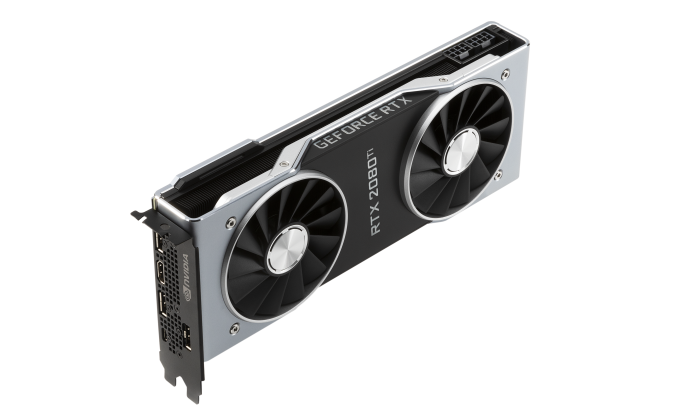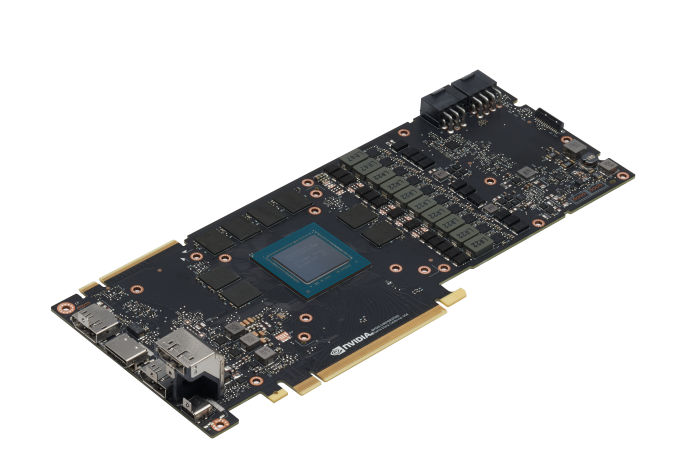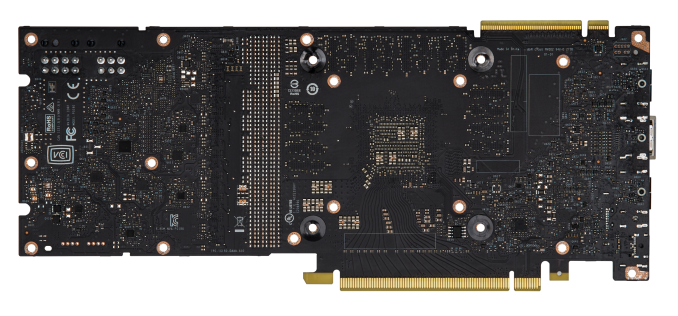The NVIDIA GeForce RTX 2080 Ti & RTX 2080 Founders Edition Review: Foundations For A Ray Traced Future
by Nate Oh on September 19, 2018 5:15 PM EST- Posted in
- GPUs
- Raytrace
- GeForce
- NVIDIA
- DirectX Raytracing
- Turing
- GeForce RTX
Meet The GeForce RTX 2080 Ti & RTX 2080 Founders Editions Cards
Moving onto the design of the cards, we've already mentioned the biggest change: a new open air cooler design. Along with the Founders Edition specification changes, the cards might be considered 'reference' in that they remain a first-party video card sold direct by NVIDIA, but strictly-speaking they are not because they no longer carry reference specifications.
Otherwise, NVIDIA's industrial design language prevails, and the RTX cards bring a sleek flattened aesthetic over the polygonal shroud of the 10 series. The silver shroud now encapsulates an integrated backplate, and in keeping with the presentation, the NVLink SLI connectors have a removable cover.
Internally, the dual 13-blade fans accompany a full-length vapor chamber and component baseplate, connected to a dual-slot aluminum finstack. Looking at improving efficiency and granular power control, the 260W RTX 2080 Ti Founders Edition features a 13-phase iMON DrMOS power subsystem with a dedicated 3-phase system for the 14 Gbps GDDR6, while the 225W RTX 2080 Founders Edition weighing in with 8-phases main and 2-phases memory.
As is typical with higher quality designs, NVIDIA is pushing overclocking, and for one that means a dual 8-pin PCIe power configuration for the 2080 Ti; on paper, this puts the maximum draw at 375W, though specifications-wise the TDP of the 2080 Ti Founders Edition against the 1080 Ti Founders Edition is only 10W higher. The RTX 2080 Founders Edition has the more drastic jump, however, with 8+6 pins and a 45W increase over the 1080's lone 8 pin and 180W TDP. Ultimately, it's a steady increase from the power-sipping GTX 980's 165W.
One of the more understated changes comes with the display outputs, which thanks to Turing's new display controller now features DisplayPort 1.4 and DSC support, the latter of which is part of the DP1.4 spec. The eye-catching addition is the VR-centric USB-C VirtualLink port, which also carries an associated 30W not included in the overall TDP.
Something to note is that this change in reference design, combined with the seemingly inherent low-volume nature of the Turing GPUs, cuts into an often overlooked but highly important aspect of GPU sales: big OEMs in the desktop and mobile space. Boutique system integrators will happily incorporate the pricier higher-end parts but from the OEM’s perspective, the GeForce RTX cards are not just priced into a new range beyond existing ones but also bringing higher TDPs and no longer equipped with blower-style coolers in its ‘reference’ implementation.
Given that OEMs often rely on the video card being fully self-exhausting because of a blower, it would certainly preclude a lot of drop-in replacements or upgrades – at least not without further testing. It would be hard to slot into the standard OEM product cycle at the necessary prices, not to mention the added difficulty in marketing. In that respect, there is definitely more to the GeForce RTX 20 series story, and it’s somewhat hard to see OEMs offering GeForce RTX cards. Or even the RT Cores themselves existing below the RTX 2070, just on basis of the raw performance needed for real time ray tracing effects at reasonable resolutions and playable framerates. So it will be very interesting to see how the rest of NVIDIA’s product stack unfolds.
















337 Comments
View All Comments
Gastec - Friday, September 28, 2018 - link
@cmdrdreddWatch out for those online scammers, you are in their target demographics ;)
Writer's Block - Monday, October 1, 2018 - link
always buy up-front.BurntMyBacon - Thursday, September 20, 2018 - link
@DigitalFreak: "He has a point. People are willing to pay $1000 for a phone, $1000 for a CPU, but $1000 for a high end graphics card is outrageous?"Fair point, but I tend to take the opposite approach and ask why people will pay more for a phone than a high end graphics card. ;')
Spunjji - Friday, September 21, 2018 - link
We're not having a fit over price, we're just not happy about it. A lot of people are digging deep to justify it, though, including making spurious arguments about the cost of things that have nothing to do with gaming GPUs. That strikes me as... not rational.$1000 phones are a great analogy, incidentally, but not for the reason you thought. It's another market area where manufacturers noticed people were sweating their assets for longer, so flimsy justifications were made for increasing the cost of entry to sustain margins. People buy it because they want it, not because it's good value.
Nvidia want to walk in here singing about a brave new world of Ray Tracing and then they tell me the cost to ride is $700+. To that I am saying nooooo thank you.
Does my not caring affect Nvidia much? No. But this is a forum, this is where we share opinions. Stop trying to act like only your opinion is rational and everyone else's is childish or misinformed.
Gastec - Friday, September 28, 2018 - link
I will NEVER pay €1000 for a smartphone. Unless of course ultra-inflation will....certainly happen in the next 15 years, when €300 now will be €1000 tomorrow. It has already started in the USA.godrilla - Wednesday, September 19, 2018 - link
Raytracing did you read the article ?Ranger1065 - Thursday, September 20, 2018 - link
Pathetic creature.Gastec - Friday, September 28, 2018 - link
@V900Soundeth like a true Avram Piltch's padawan :)
V900 - Wednesday, September 19, 2018 - link
BTW: Why do I get the distinct impression, that most of the people complaining about the price, would insist that it’s a totally fair and reasonable price, if this was an AMD graphics card?Qasar - Wednesday, September 19, 2018 - link
if this was an amd card.. it still would be too much, and i still wouldnt get one...